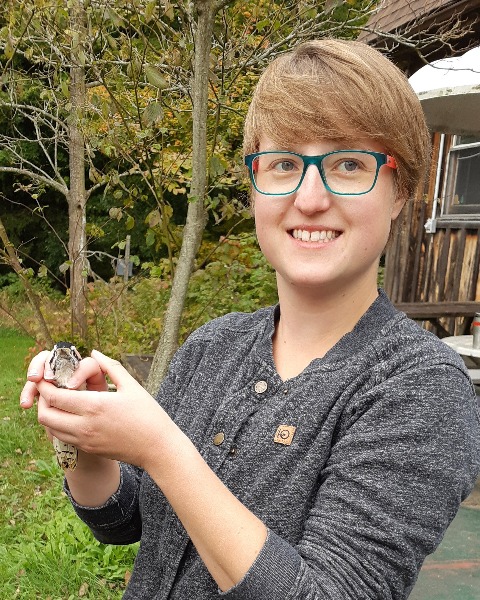Back
Contributed Talk
Session: Parasitism And Host-Parasite Interactions 1
COS 220-3 - Ectoparasite diversity of two sympatric Atlantic Canadian bat species, Myotis lucifugus and Myotis septentrionalis
Thursday, August 18, 2022
8:30 AM – 8:45 AM EDT
Location: 514C

Alexandra H. Sauk
PhD Candidate
University of Waterloo - Waterloo, ON
Waterloo, Ontario, Canada- HB
Hugh G. Broders
Professor
University of Waterloo - Waterloo, ON
Waterloo, Ontario, Canada
Presenting Author(s)
Coauthor(s)
Background/Question/Methods
Ectoparasite abundance and diversity are affected by various abiotic and biotic factors ranging from temperature and humidity to host species and sex. The little brown myotis (Myotis lucifugus) and the northern myotis (Myotis septentrionalis) are sympatric insectivorous bats in Atlantic Canada that exhibit different grouping behaviour. Previous research has identified ectoparasite assemblages infecting these bat species in Nova Scotia and New Brunswick. We expand on this previous work by assessing patterns of ectoparasite diversity and evaluating the role of abiotic (e.g., geography and climate) and biotic (e.g., host species and sex) factors in generating these patterns for ectoparasites of M. lucifugus and M. septentrionalis across Atlantic Canada. Ectoparasites were collected opportunistically from the wings, body, and ears from bats caught for other research projects between 1999 and 2017. Ectoparasites were examined using microscopy and identified to the lowest taxonomic rank possible using morphological characteristics. Species richness and associated species accumulation curves were calculated per bat and per sampling site. Linear models were used to test for spatial, climatic, and host factors influencing ectoparasite diversity with species richness and Shannon-Wiener diversity used as response variables.
Results/Conclusions
A total of 2789 ectoparasites were collected from 981 Myotis lucifugus and 197 M. septentrionalis. The wing mite Spinturnix americanus and the bat flea Myodopsylla insignis were the most frequently collected ectoparasites, accounting for 63% and 30% of the total, respectively. Small numbers of the bat bug Cimex adjunctus and other mite and flea species were also collected. The collection also includes 120 mites < 1 mm in length that are currently identified to order Mesostigmata. This research will provide insight into the diversity of bat ectoparasites in Atlantic Canada and the factors shaping their communities. Additionally, the collection of ectoparasites for this research was completed prior to the white-nose syndrome (WNS) causing fungus Pseudogymnoascus destructans being reported in Atlantic Canada. Both M. lucifugus and M. septentrionalis have experienced dramatic population collapse in Atlantic Canada which may have repercussions for the survival of their ectoparasites. This study will provide a baseline understanding of the ectoparasite communities to assess how these ectoparasite communities have changed post-WNS.
Ectoparasite abundance and diversity are affected by various abiotic and biotic factors ranging from temperature and humidity to host species and sex. The little brown myotis (Myotis lucifugus) and the northern myotis (Myotis septentrionalis) are sympatric insectivorous bats in Atlantic Canada that exhibit different grouping behaviour. Previous research has identified ectoparasite assemblages infecting these bat species in Nova Scotia and New Brunswick. We expand on this previous work by assessing patterns of ectoparasite diversity and evaluating the role of abiotic (e.g., geography and climate) and biotic (e.g., host species and sex) factors in generating these patterns for ectoparasites of M. lucifugus and M. septentrionalis across Atlantic Canada. Ectoparasites were collected opportunistically from the wings, body, and ears from bats caught for other research projects between 1999 and 2017. Ectoparasites were examined using microscopy and identified to the lowest taxonomic rank possible using morphological characteristics. Species richness and associated species accumulation curves were calculated per bat and per sampling site. Linear models were used to test for spatial, climatic, and host factors influencing ectoparasite diversity with species richness and Shannon-Wiener diversity used as response variables.
Results/Conclusions
A total of 2789 ectoparasites were collected from 981 Myotis lucifugus and 197 M. septentrionalis. The wing mite Spinturnix americanus and the bat flea Myodopsylla insignis were the most frequently collected ectoparasites, accounting for 63% and 30% of the total, respectively. Small numbers of the bat bug Cimex adjunctus and other mite and flea species were also collected. The collection also includes 120 mites < 1 mm in length that are currently identified to order Mesostigmata. This research will provide insight into the diversity of bat ectoparasites in Atlantic Canada and the factors shaping their communities. Additionally, the collection of ectoparasites for this research was completed prior to the white-nose syndrome (WNS) causing fungus Pseudogymnoascus destructans being reported in Atlantic Canada. Both M. lucifugus and M. septentrionalis have experienced dramatic population collapse in Atlantic Canada which may have repercussions for the survival of their ectoparasites. This study will provide a baseline understanding of the ectoparasite communities to assess how these ectoparasite communities have changed post-WNS.
